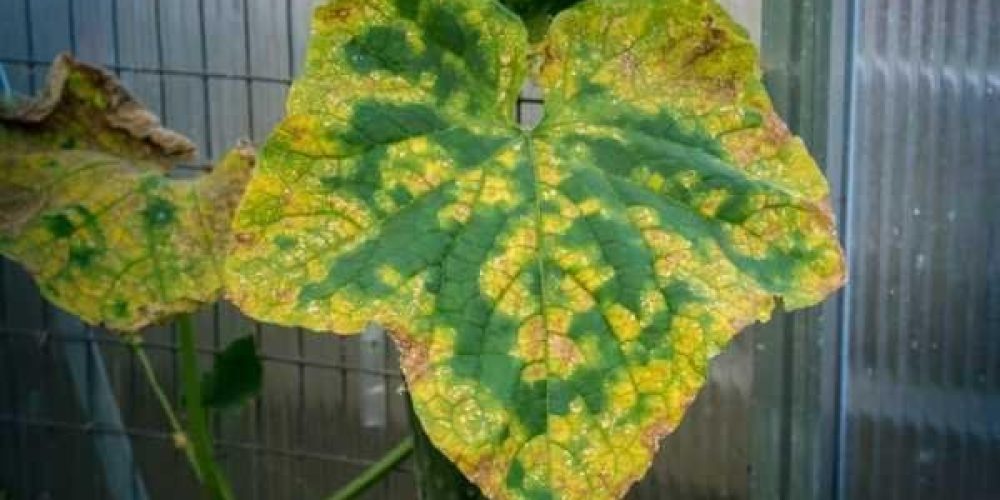Table of contents of the article
ToggleAnthracnose is a fungal disease that affects cucumber plants, causing sunken spots on the fruits and leaves. This article from the World of Plants website reviews the symptoms of this disease and methods of effective prevention and control of anthracnose in cucumbers.
The anthracnose family of cucumbers
- Name of the disease: Anthracnose Anthracnose
- Scientific name: Colletotrichum gloeosporioides
It attacks cucumbers, watermelons, and cantaloupes in the Arab region. It may attack the plant at any time, whether at the beginning of the season or after fruit formation. The disease rarely attacks other members of the cucurbit family, such as pumpkin or zucchini.
It may affect fruits, stems or leaves.
Symptoms of anthracnose in cucumber
Symptoms appear six days after the infection occurs, and appear in the form of yellow spots saturated with water that quickly turn brown and then black on older leaves. These spots increase in size to cover the entire surface of the leaf, and then the leaves die and fall. The disease also attacks the plant stem and fruits. The spots appear black, as if saturated with water, and are circular in shape, with a black center, especially in ripe fruits, which have an unacceptable taste. The disease also causes deformation of fruits. Symptoms appear 96 hours after infection.
Causes of anthracnose in cucumbers
The disease is caused by the fungus Colletotrichum lagenarium, which is a fungus that has no known sexual phase. It can live up to five years by surviving on the remains of infected plants from the previous season. The disease is spread by irrigation water, rain-laden winds, and also by seeds taken from infected plants. The fungus penetrates the leaves directly within 72 hours and does not need natural openings to enter.
Suitable conditions for the spread of anthracnose in cucumbers
This disease needs warm, humid weather, and the suitable temperature for it ranges from 22 to 28 degrees Celsius. Rain is necessary at the time the infection occurs, as the initial infection requires a humidity level of 100% for at least 24 hours in order for the conidia to germinate, and therefore the risk of the disease to crops increases in the event of summer rains.
Development cycle of anthracnose in cucumber
The fungus reproduces in sporangial cysts, which germinate, forming ciliate spores with penetrating tubes. Therefore, the fungus remains between seasons in the form of mycelium in infected plants and herbs belonging to the Cucurbit family. The fungus enters the plant tissues through stomata and grows in them, where it forms conidial spores. Within a week of the start of the infection, these spores are transmitted. To cause repeated infection by wind and rain, the incubation period for the disease is 4/12 days, and sporangia cysts form four days after the infection occurs.
Losses from the spread of anthracnose in cucumbers
The disease affects the leaves, stems and fruits and affects production as well as the quality of the fruits, making them unmarketable.
Strategy for controlling anthracnose in cucumbers
المكافحة الكيميائية وحدها لا تكفي ما لم تتخذ جميع التدابير الوقائية ويجب يجري الرش بالمبيدات كل 5-10 أيام عند بدء ظهور الإصابة، تطبق المبيدات بشكل منتظم مع حدوث الأمطار الغزيرة كل 5 أيام.
Preventive measures to prevent the occurrence of anthracnose in cucumbers
Removing plant residues, disinfecting the greenhouse, etc. Before planting seedlings, carefully inspect each seedling for signs of anthrax. Remove diseased shoots immediately. To prevent the disease from spreading among mature plants, the affected shrub must also be carefully removed from the garden or greenhouse and burned. If you notice signs of the disease at a very early stage, its development can be easily stopped by reducing the air humidity to 60%.
Recommendations for organic and chemical control of anthracnose in cucumber
- Use natural fungicides... These include mustard, aloe vera and alcoholic herbal infusions: in a 2% aqueous solution of mustard seeds are placed for 6 hours, in alcoholic herbal tinctures – for 1 hour. Place the aloe vera leaves in the refrigerator for 5-6 days, then extract the juice from them, dilute them with water 1:1, and place the seeds in it for a day.
- Planting resistant varieties and treating the seeds with fungicides, as the fungus can be transmitted with the seeds and they are treated with Cerazan or soaked in water containing some garlic juice for two days immediately before planting.
- Treating the soil with chemical evaporators or using solar energy.
- Do not plant crops infected with this disease for a period of not less than three years on lands contaminated with fungal spores.
- Spray the plants with fungicides belonging to the dithiocarbamate group early in the season, and repeat the spraying every two weeks from one to three times.
- Do not wash the fruits, leave them dry, and reduce the humidity in the stores.
- Controlling weeds belonging to the Cucurbitaceae family.
- Do not handle plants when they are wet with rain water or dew drops.
In conclusion, we would like to note that we, at the world of plants website, offer you all the necessary services in the world of plants, we provide all farmers and those interested in plants with three main services::-
- Artificial intelligence consulting service to help you identify diseases that affect plants and how to deal with them.
- Blog about plants, plant diseases and care of various crops ... You are currently browsing one of her articles right now.
- An application that provides agricultural consultations to clients, as well as a service for imaging diseases and knowing their treatment for free – Click to download the Android version from Google Play Store، Click to download the IOS version from the Apple App Store.





